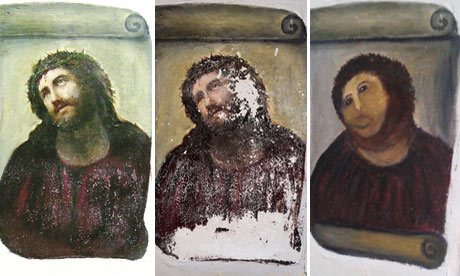It is inconceivable the amount of talent and precision so many artists through time have put into the great works of art we know today. Recreating them, conserving them, physically fixing them as they age, is an even more mind blasting task. A blunder in the art conservation industry does not go unnoticed. Take for instance the viral event of the ruined church fresco, outside of Zaragoza, Spain. Here, an elderly female parishoner took it upon herself to revitalize the flaking fresco of “Ecce Homo” (meaning “Behold the Man”). Cecilia Gimenéz took responsibility for the almost irrepairable tempera work depicting Jesus.

"Ecco Homo" (Behold the Man) Restoration, www.guardian.co.uk
Granted, Gimenéz was not even remotely a trained professional, however, can you imagine the great responsibility of holding a piece of history in your hands and being expected to keep it in tact, just as the artist intended.
This is what Kathleen Gilje does for a living, a trained conversator of art, at the collection of Capodimonte Museum in Naples, Italy. Now she is taking a new approach to restoring art, and she is beginning to create her own expressions, as opposed to just maintaining the expressions of others. Kathleen described working in art conservation as being on the “outside” of the art world, in a New York Times interview. However, as she develops in her field and as an artist, she says she feels more of a sense of belonging for the art world.

Kathleen Gilje Self-Portrait with Paintbrush after Bouguereau's The Assault, 2012, www.brucemuseum.org
On exhibit at the Bruce Museum in Greenwich, Connecticut, “Revised and Restored: the Art of Kathleen Gilje,” Gilje is working on redirecting her talents as a restorer and beginning to reconstruct the old classics. The exhibition holds a satirical theme, and comments on social, political and art historical issues of our day.

Kathleen Gilje, Linda Nochlin at the Bar at the Folies-Bergère, 2005, www.nytimes.com
Linda Nochlin, shown in this recreation, is one of the leaders in the study of feminist art history and is an American art historian and university professor. A number of the works in Gilje’s exhibit address themes of feminity and gender and the objectification of women, which is a subject that has been closely tied to Manet’s original Bar at the Folies-Bergères.

Kathleen Gilje, Lady with an Ermine, 1997, www.brucemuseum.org
As part of the exhibit, the audience is given essays by both Ms. Nochlin and art historian Robert Rosenblum, whose writings look at the returning concern for studying the past – that new generations of artists are going back to galleries and textbooks and learning from their predecessors, as opposed to deperately escaping the shadow of art’s past. Gilje is a perfect example of an artist turning to the past for guidance and education in the field of painting.

Kathleen Gilje, Comtesse d’Haussonville, 1994-96, www.brucemuseum.org
As a budding art historian myself, I sometimes fear for the arts as we barrel down the road towards the future of digital art, viral expressions, and collaged multimedia. I love all forms of art, however, there is something to be said for the talent it takes to paint in oil or on canvas, just as the great artists once did. Looking back at their works and understanding an artwork’s context can make a political message, embedded by the artist, seem so blatant and obvious, in the best sense. Gilje has done the same with her tribute to the old, as she comments on new issues.

Kathleen Gilje, Basquiat as Velázquez’s Portrait of Juan de Pareja, 2011, www.brucemuseum.org
Not only has Kathleen Gilje triumphed in the field of conservation, she has been bold enough to create her own art regarding her field, and even more so, she has been brave enough to attempt to recreate works by some of the great and most renowned artists. Her approach and creativity in this project is exceptional. Should you be in the Greenwich area, be sure to drop by the exhibit and let us know what you think, here on WallSpin.
Related articles







Comments (0)